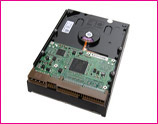Posted on September 29th, 2009 by ASEE
 Frustrated by gridlock? Traffic engineers feel your pain. Using math, they devise ways to improve the flow of vehicles at busy intersections and on highways. Here is an example of the kind of problem they might try to solve. Designed for advanced high-school algebra students, it can be worked out most easily using Microsoft Excel.
Frustrated by gridlock? Traffic engineers feel your pain. Using math, they devise ways to improve the flow of vehicles at busy intersections and on highways. Here is an example of the kind of problem they might try to solve. Designed for advanced high-school algebra students, it can be worked out most easily using Microsoft Excel.
Read More
Filed under: Grades 9-12, Lesson Plans | Comments Off on Lesson: Better Traffic Flow
Tags: Research on Learning
Posted on September 15th, 2009 by als
 Hurricane season is here, reminding us that accurate weather forecasts can be a matter of life and death in vulnerable coastal areas of the country. Even inland, severe thunderstorms play havoc with late-summer travel, and tornadoes threaten lives and property. In this lesson for grades 6 to 8, students begin by considering how weather forecasting plays an important part in their daily lives. They learn about the history of weather forecasting — from old weather proverbs to modern forecasting equipment — and how improvements in weather technology have saved lives by providing advance warning of natural disasters.
Hurricane season is here, reminding us that accurate weather forecasts can be a matter of life and death in vulnerable coastal areas of the country. Even inland, severe thunderstorms play havoc with late-summer travel, and tornadoes threaten lives and property. In this lesson for grades 6 to 8, students begin by considering how weather forecasting plays an important part in their daily lives. They learn about the history of weather forecasting — from old weather proverbs to modern forecasting equipment — and how improvements in weather technology have saved lives by providing advance warning of natural disasters.
Read More
Filed under: Class Activities, Grades 6-8, Grades 6-8, Grades K-5, Lesson Plans | 1 Comment »
Tags: Environmental Engineering, Research on Learning, Technology for Learning, Wind Technology
Posted on August 6th, 2009 by als
 In this two-hour activity for grades 7-9, students learn about the practical uses, structure, mathematics and terminology of the binary number system. They learn how to convert a given number from the binary to the decimal number system and vice versa, and perform binary addition and subtraction as part of a class game. They use this understanding to build their own simple, mechanical “hard drive” — a box that uses binary numbers to represent words for later retrieval.
In this two-hour activity for grades 7-9, students learn about the practical uses, structure, mathematics and terminology of the binary number system. They learn how to convert a given number from the binary to the decimal number system and vice versa, and perform binary addition and subtraction as part of a class game. They use this understanding to build their own simple, mechanical “hard drive” — a box that uses binary numbers to represent words for later retrieval.
Read More
Filed under: Class Activities | Comments Off on Activity: Build a Hard Drive
Posted on June 4th, 2009 by ASEE

In this activity for grades 6-12, students design a seawall to protect a major coastal highway from erosion by ocean waves and address these questions: Erosion–can you fight it? How much energy is involved with waves and erosion? Can humans stop erosion of the shoreline? Should we? Is it cost effective?
Read More
Filed under: Class Activities, Grades 6-8, Grades 9-12 | Comments Off on Activity: Prevent Shore Erosion
Tags: Marine engineering, Math Lesson Plans, Mathematics
Posted on April 22nd, 2009 by ASEE
 In this two-period activity for grades 3 and 4, students learn the basics of engineering associated with the design of telephones to make them more accessible for people who have a visual or hearing impairment or who lack fine motor skills.
In this two-period activity for grades 3 and 4, students learn the basics of engineering associated with the design of telephones to make them more accessible for people who have a visual or hearing impairment or who lack fine motor skills.
Read More
Filed under: Class Activities, Grades K-5 | Comments Off on Activity: Phones for Special Needs
Posted on April 8th, 2009 by ASEE
 Students use an old fashioned children’s toy, a metal slinky to mimic and understand the magnetic field generated in an Magnetic Resonance Imaging (MRI) machine. Students run a current through the slinky and use computer and calculator software to explore the magnetic field created by the slinky.
Students use an old fashioned children’s toy, a metal slinky to mimic and understand the magnetic field generated in an Magnetic Resonance Imaging (MRI) machine. Students run a current through the slinky and use computer and calculator software to explore the magnetic field created by the slinky.
Read More
Filed under: Class Activities, Grades 9-12 | Comments Off on Activity: Slinkies and Magnetic Fields
Tags: Biomedical Engineering, Physics
Posted on March 9th, 2009 by ASEE
 In this activity for grades 4 through 6, students become acquainted with the engineering principles and forces that help support bridges. Then 16 students form a human suspension bridge.
In this activity for grades 4 through 6, students become acquainted with the engineering principles and forces that help support bridges. Then 16 students form a human suspension bridge.
Read More
Filed under: Class Activities, Grades 6-8, Grades K-5 | 1 Comment »
Tags: Bridge building, Civil Engineering
Posted on February 12th, 2009 by ASEE
 In this activity for grades 1 to 6, students create a paper flyer that moves like the blades of a helicopter. They learn how changing the helicopter’s shape or weight affects its flight and explore how air resistance changes the way an object falls.
In this activity for grades 1 to 6, students create a paper flyer that moves like the blades of a helicopter. They learn how changing the helicopter’s shape or weight affects its flight and explore how air resistance changes the way an object falls.
Read More
Filed under: Class Activities, Grades 6-8, Grades K-5 | 5 Comments »
Tags: Aerodynamics, Class Activities, Grades 6-8, Grades K-5
Posted on January 26th, 2009 by ASEE
 What is science for a child? How do children learn about science and how to do science? Drawing on a vast array of work from neuroscience to classroom observation, Taking Science to School provides a comprehensive picture of what we know about teaching and learning science from kindergarten through eighth grade.
What is science for a child? How do children learn about science and how to do science? Drawing on a vast array of work from neuroscience to classroom observation, Taking Science to School provides a comprehensive picture of what we know about teaching and learning science from kindergarten through eighth grade.
Read More
Filed under: Grades 6-8, Grades K-5, K-12 Education News | Comments Off on Taking Science to School
Tags: Research on Learning, Teacher Training
 Frustrated by gridlock? Traffic engineers feel your pain. Using math, they devise ways to improve the flow of vehicles at busy intersections and on highways. Here is an example of the kind of problem they might try to solve. Designed for advanced high-school algebra students, it can be worked out most easily using Microsoft Excel.
Frustrated by gridlock? Traffic engineers feel your pain. Using math, they devise ways to improve the flow of vehicles at busy intersections and on highways. Here is an example of the kind of problem they might try to solve. Designed for advanced high-school algebra students, it can be worked out most easily using Microsoft Excel.








 Hurricane season is here, reminding us that accurate weather forecasts can be a matter of life and death in vulnerable coastal areas of the country. Even inland, severe thunderstorms play havoc with late-summer travel, and tornadoes threaten lives and property. In this lesson for grades 6 to 8, students begin by considering how weather forecasting plays an important part in their daily lives. They learn about the history of weather forecasting — from old weather proverbs to modern forecasting equipment — and how improvements in weather technology have saved lives by providing advance warning of natural disasters.
Hurricane season is here, reminding us that accurate weather forecasts can be a matter of life and death in vulnerable coastal areas of the country. Even inland, severe thunderstorms play havoc with late-summer travel, and tornadoes threaten lives and property. In this lesson for grades 6 to 8, students begin by considering how weather forecasting plays an important part in their daily lives. They learn about the history of weather forecasting — from old weather proverbs to modern forecasting equipment — and how improvements in weather technology have saved lives by providing advance warning of natural disasters. In this two-hour activity for grades 7-9, students learn about the practical uses, structure, mathematics and terminology of the binary number system. They learn how to convert a given number from the binary to the decimal number system and vice versa, and perform binary addition and subtraction as part of a class game. They use this understanding to build their own simple, mechanical “hard drive” — a box that uses binary numbers to represent words for later retrieval.
In this two-hour activity for grades 7-9, students learn about the practical uses, structure, mathematics and terminology of the binary number system. They learn how to convert a given number from the binary to the decimal number system and vice versa, and perform binary addition and subtraction as part of a class game. They use this understanding to build their own simple, mechanical “hard drive” — a box that uses binary numbers to represent words for later retrieval.
 In this two-period activity for grades 3 and 4, students learn the basics of engineering associated with the design of telephones to make them more accessible for people who have a visual or hearing impairment or who lack fine motor skills.
In this two-period activity for grades 3 and 4, students learn the basics of engineering associated with the design of telephones to make them more accessible for people who have a visual or hearing impairment or who lack fine motor skills. Students use an old fashioned children’s toy, a metal slinky to mimic and understand the magnetic field generated in an Magnetic Resonance Imaging (MRI) machine. Students run a current through the slinky and use computer and calculator software to explore the magnetic field created by the slinky.
Students use an old fashioned children’s toy, a metal slinky to mimic and understand the magnetic field generated in an Magnetic Resonance Imaging (MRI) machine. Students run a current through the slinky and use computer and calculator software to explore the magnetic field created by the slinky. In this activity for grades 4 through 6, students become acquainted with the engineering principles and forces that help support bridges. Then 16 students form a human suspension bridge.
In this activity for grades 4 through 6, students become acquainted with the engineering principles and forces that help support bridges. Then 16 students form a human suspension bridge. In this activity for grades 1 to 6, students create a paper flyer that moves like the blades of a helicopter. They learn how changing the helicopter’s shape or weight affects its flight and explore how air resistance changes the way an object falls.
In this activity for grades 1 to 6, students create a paper flyer that moves like the blades of a helicopter. They learn how changing the helicopter’s shape or weight affects its flight and explore how air resistance changes the way an object falls. What is science for a child? How do children learn about science and how to do science? Drawing on a vast array of work from neuroscience to classroom observation, Taking Science to School provides a comprehensive picture of what we know about teaching and learning science from kindergarten through eighth grade.
What is science for a child? How do children learn about science and how to do science? Drawing on a vast array of work from neuroscience to classroom observation, Taking Science to School provides a comprehensive picture of what we know about teaching and learning science from kindergarten through eighth grade.